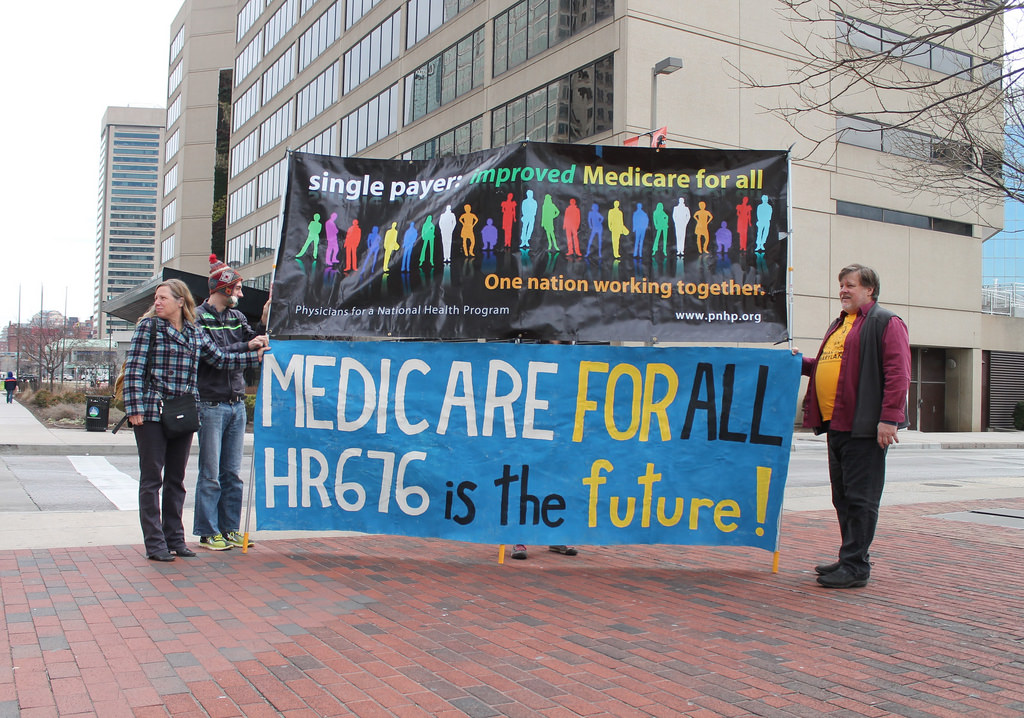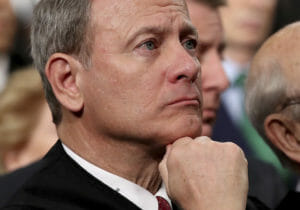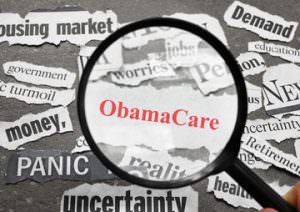The Path to National Improved Medicare for All
State efforts hinder national efforts. To create single payer at a state level requires changing federal law. A National Medicare for All protest in Baltimore. (Elvert Barnes / CC BY-SA 2.0)
A National Medicare for All protest in Baltimore. (Elvert Barnes / CC BY-SA 2.0)
Two states with a long history of state-based health care reform efforts, California and New York, are hard at work organizing for state bills labeled as single-payer health care plans. Other states are moving in that direction too. This raises questions by single-payer advocates: Can states create single-payer health care systems? Does state-level work help or hinder our goal of National Improved Medicare for All (NIMA)?
The movement for NIMA gained momentum throughout 2017, largely due to rising premiums under the Affordable Care Act (ACA) and Republican efforts to worsen the health care crisis. Supporters of NIMA mobilized to build support for single-payer legislation in Congress, spoke out at town halls and pressured lawmakers. As a result, the House bill, HR 676: The Expanded and Improved Medicare for All Act, grew to 120 co-sponsors, the highest number in its 15-year history, and Senator Sanders was successfully pressured to introduce a bill in the Senate, S 1804: The Medicare for All Act.
As momentum grew, the expected pushback materialized. In the spring, Democrats in Congress urged people to focus on fixing the ACA and uttered support for various forms of a public insurance, a “public option” or Medicare buy-in. In August, well-known progressives, claiming to be “single-payer supporters,” published articles arguing that single payer was too much to ask for and outlining “incremental approaches.” Members of Congress, including Speaker Nancy Pelosi, complained about Democratic voters making single payer a litmus test in the next elections. Pelosi said, “So I say to people, if you want [single payer], do it in your states. States are laboratories.” The message was clear. There was too much pressure for NIMA, and Democrats didn’t like it. Sending people to work at the state level would lower the heat on Congress.
State Efforts for Universal Health Care
Canada is often pointed to as a model for achieving National Improved Medicare for All in the United States. A universal medical insurance was first created in the province of Saskatchewan in 1962, following decades of increasing socialization of medicine in several provinces and a national law that financed universal hospital coverage at the provincial level. By 1968, a universal publicly financed Medicare program was adopted nationally. Could the same path occur in the U.S.?
The 21st-century health care system in the United States is much more complex than the Canadian system was in the 1960s. At that time, health care was left up to the provinces. Dr. Don McCanne writes, “We cannot use the example of Saskatchewan and pretend that a state can set up a single-payer system that could serve as an example for the nation—a model that could be expanded to all states. No. Saskatchewan began with a tabula rasa. They were able to create a de novo single-payer system.”
Rather than socializing medicine, the U.S. has experienced decades of increasing privatization. There are a multitude of payers in the U.S., which include private insurance through employers, unions and individually, public programs, and national programs for federal employees and the military. A state would have to succeed in obtaining multiple waivers from the federal government and changes to federal laws to enact a state-based program. One federal law, the Employee Retirement and Income Security Act of 1974 (ERISA), which prohibits states from regulating employee benefits, is a major obstacle. States also face the hurdle of being required to balance their budgets, a barrier that doesn’t exist at the national level.
As outlined in Public Citizen’s “Road Map to Single Payer,” a state can potentially make its health care system more efficient, but it cannot achieve a pure single-payer system; thus, it can’t attain the bulk of savings that a single-payer system would have. Within their budget constraints, states would be forced to raise the costs to individuals and businesses or lower coverage if they are not able to meet their needs for care. This has happened in every past attempt by states to achieve universal coverage, as Drs. Steffie Woolhandler and David Himmelstein document in “State Health Reform Flatlines.”
If a state were able to pass a bill outlining a path toward a universal health care system and to be granted a federal waiver from the Affordable Care Act (ACA), which are major feats, the state would still face significant barriers, some of which make it impossible to create a pure single-payer program.
Barriers to state single payer
1. Federal Health Plans—There are numerous federal health plans, such as Medicare for seniors and those who qualify for disability, the Federal Employee Health Benefits Program (FEHBP), which includes over 200 plans, the Veterans Health Administration (VA), the Indian Health Service (IHS) and Tri-Care for members of the military; it is not possible to merge all these programs into a single state system.
The Center for Medicare and Medicaid Services (CMS) does not have the authority to give federal Medicare dollars to the state as a block grant. Single-payer advocates have opposed passing a federal law that would allow this due to concern that it would dismantle the Medicare program state by state and allow some states to use the law to further privatize Medicare through vouchers.
Some state advocates have considered applying for a new state health care plan to be considered a Medicare Advantage plan. These are private plans offered under Medicare. If such a waiver were granted, the state still could not force seniors to choose the state plan, so it would only capture some of the Medicare recipients in the state.
There is a similar situation with the health plans for federal employees. It would require a change in federal law to shift the FEHBP to the state. Perhaps a state could apply to be considered a choice for federal employees but even if it succeeded, it could not compel federal employees to choose their plan. Tri-Care is a program run by the Department of Defense that would also continue to operate outside the new state system. And the VA and IHS would operate independently as well.
It is possible, although this has not been tried yet, that a state could become an intermediary between providers in the state and the various federal programs such that claims would be submitted to the state and the state would collect the payment from the federal program to pay the provider. This would add more administrative complexity and cost to the state program, and providers would still have to interact with the individual plans for authorization of care.
2. Medicaid—Medicaid is a federal program for people with low incomes administered at the state level. A state would have to apply for a waiver to incorporate Medicaid into its new state program. There is greater flexibility for a state to do this than there is for Medicare. States would still have to track how many people qualify for Medicaid to be reimbursed for them by the federal government, another administrative task that adds cost, or would need to ask for a block grant. Single-payer advocates have opposed turning Medicaid into a block grant program because that would limit funds during periods of recession when more people qualify for Medicaid. A block grant would not expand as the need expanded. Currently, all states except Connecticut use a mix of private insurance Managed Care Organizations (MCOs) for Medicaid patients. To streamline its Medicaid system, a state would need to get rid of its multiple Medicaid MCOs.
3. Employer Health Plans—Employee benefits are protected under a federal law, the Employee Retirement Income Security Act of 1974 (ERISA). While states have the authority to regulate health insurers that operate in their state, they do not have authority to regulate plans offered by businesses that self-insure, which is 60 percent of businesses that provide health benefits. Any interference in employee benefits can be challenged under ERISA and would result in a lengthy and expensive court battle.
California and New York are trying to circumvent ERISA by stating explicitly that their state program “does not create any employment benefit, nor does it require, prohibit, or limit the providing of any employment benefit.” However, a state system would be challenged under ERISA, and recent ERISA challenges have not been favorable. A case between the state of Vermont and Liberty Mutual, which operates as an ERISA plan, went to the U.S. Supreme Court in 2016 and was decided against the state. The case involved a law requiring insurers to report claims data. Even though the Vermont law did not specifically target ERISA plans, it was determined to be preempted by ERISA because it had a “connection” to the ERISA plan. Another impermissible “connection” would occur if “economic effects of the state law force an ERISA plan to adopt a certain scheme of substantive coverage or effectively restrict its choice of insurers.” A state law requiring businesses to pay a payroll tax would likely be viewed as restricting choice.
States can strive for universal coverage, but calling plans single payer is incorrect.
For many decades, states have introduced and passed laws aimed at achieving universal health care coverage. None has yet succeeded in being universal or sustainable, but these are admirable efforts that have increased access to care, at least temporarily. It is possible for a state, using the roadmap outlined by Public Citizen, to move toward universal coverage. It is not possible to achieve a pure single-payer system at the state level and so states forego the significant savings of a single-payer system.
In the drive toward universal health care, states might consider working to get rid of private Medicaid MCOs as Connecticut did so that more Medicaid dollars are available to cover more people and/or more care. Oklahoma had a similar program that was successful. Part of the success of these programs is providing case management for people with significant health needs to avoid preventable emergency room visits and hospitalizations.
Given that states are not able to achieve pure single-payer systems, states take a risk when they label themselves single payer or Medicare for All. While it is understandable that these terms are popular and that most advocates for health reform support single payer, and so are inspired to work for it, it is misleading and could harm national efforts.
For example, Vermont passed a law in 2010 requiring the state to develop a plan for universal health care coverage. That law allowed the state to contract Dr. William Hsaio, who assisted in the design of the Taiwanese single-payer healthcare system in the 1990s, to design their system. Vermont’s system was not a single-payer system, yet it was consistently called single payer by the governor, advocates and the media. It failed, and its failure was blamed on its high cost.
Similarly, Colorado attempted universal health care coverage in 2016 through the creation of a state-wide publicly financed health care cooperative: “ColoradoCare would have replaced most private health insurance and taken over the state’s Medicaid program for the poor and people with disabilities, starting in 2019. The ballot initiative did not seek to replace Medicare benefits or current health coverage for veterans, military personnel and civilian defense employees.”
The Colorado plan was called single payer, even though it wasn’t, and its defeat was marked in the media as a second defeat for single-payer health care. Prominent Democrats opposed ColoradoCare. Some progressive groups in Colorado also declined to support it, saying that single payer can only be done at the national level. It is hard to argue with them when they are correct. It undermines our legitimacy if single-payer advocates are on the inaccurate side of that argument.
Do state efforts help or hinder national efforts?
Advocates for “single payer” at the state level often say that state efforts will help national efforts. Some advocates work for reform at the state level because they believe the public will be more inspired to fight for change at the local than at the national level.
It is true that it is often easier to engage people around local or state efforts. They feel more winnable. But what happens when the public is told they are working for state-based single payer and then they find out that they have been misled because the goal is not possible? It may be that public trust is lost or that people experience a deep disappointment because they worked hard for something that will never be realized.
And what would happen if a state succeeded in passing a health law? First, it would take a tremendous effort focused on influencing state, not national, legislators to pass it. Second, that level of state-based pressure would have to be maintained to implement the law. And third, a state campaign would be so focused on these efforts that it would have little time or resources to advocate for change at the national level. Their national fight would be aimed at applying for waivers and winning changes to the Medicare law and ERISA.
Imagine if a highly populated progressive state such as California or New York were to drop out of the national effort for NIMA to focus on their state. This would be a huge loss. Dr. Woolhandler reminds us, “Living in New York or Massachusetts doesn’t lessen our sense of responsibility for millions in the Deep South and other ‘red state’ areas for whom national legislation is the only realistic option for health care progress.”
The only way we will achieve National Improved Medicare for All is if we develop a movement of movements and strategic campaigns focused on that goal. It is going to be a fight, but it is a winnable fight, especially now as the ACA becomes unsustainable and Congress threatens the minor safety net currently in existence. To win, we need to continue to build momentum in our states to pressure members of Congress. This election year is a perfect time to do that, particularly during the primaries when candidates are sensitive about their image.
We need to connect our fights to other struggles to protect public insurances such as Medicaid and Medicare. The solution to preserving our social health systems is to make them universal. Then we have the social solidarity, everybody in and nobody out, to protect and strengthen them.
A study of social movements shows us that we are close to winning NIMA. The power holders will predictably work to throw us off track by sending us down false paths of partial reforms and state-based efforts and lure us into working on elections. We must recognize and resist these distractions. We will win when we have built the popular power to shift the political culture so that no politician can be on the wrong side of this issue. We win when there is a loud and clear public demand for National Improved Medicare for All.
Your support is crucial…With an uncertain future and a new administration casting doubt on press freedoms, the danger is clear: The truth is at risk.
Now is the time to give. Your tax-deductible support allows us to dig deeper, delivering fearless investigative reporting and analysis that exposes what’s really happening — without compromise.
Stand with our courageous journalists. Donate today to protect a free press, uphold democracy and unearth untold stories.






You need to be a supporter to comment.
There are currently no responses to this article.
Be the first to respond.